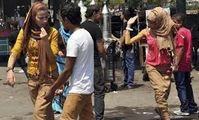Egypt: Photographing the Orient

Created: Aug 28, 2010,
modified: Jan 13, 2012,
overall rating: 0.000
Something of a minor Cairo landmark, the Lehnert and Landrock bookshop has been selling photographs of the Orient since the 1920s.
Anyone walking down Sherif Street in downtown Cairo is likely to have had their eyes drawn to the Lehnert and Landrock bookshop. Its window display signaling the many treasures inside. These consist of hundreds of old photographs that the original owners have left us, a heritage of indescribable beauty that pictures an 'Orient' that no longer exists.
One of the original owners, Rudolf Lehnert, was born in Bohemia in July 1878. His partner Ernst Landrock was born in Germany a month later. Lehnert, a gifted photographer, was the more artistically inclined of the two, with Landrock being the one with more business acumen. In today's terminology, Landrock would be the agent acting to promote Lehnert's work.
It was when Lehnert was touring Europe on foot in 1903, that he decided to venture across the Mediterranean to look at sites in Tunisia. He ended up staying there for a year, and it was during this time that his friendship with Landrock began.
While in Tunisia, Lehnert started taking photographs of 'oriental' subjects using the glass plate technology of the time.
Soon, the work produced by Lehnert and Landrock in Tunisia was taking Europe by storm. French and German collectors vied for prints of the photographs, and it was only the outbreak of World War I in 1914 that interrupted the two men's work in Tunisia, from where they moved to Cairo in 1924.
Lehnert and Landrock's first shop in Cairo was located just a short distance from the current bookshop in Sherif Street. They paid what was then the large sum of LE30 a month for an eight room apartment in a building called Bannani on 21 Al-Maghrabi Street, now Adli Street in downtown Cairo.
Said Ali Mohamed, who has worked at the shop for 30 years and now runs it, says that the two men were interested from the start in documenting Egyptian antiquity. However, Lehnert also branched out as usual, photographing various aspects of life in Egypt during the 1920s and 1930s.
In 1930, Lehnert sold his half of the negatives to Landrock and left him in charge of the bookshop. Before leaving Egypt, he is said to have commented that, "I have left photographs behind me that will live for 200 years." Few today would dispute his assessment.
For his part, Landrock, now running the business alone, remained in Egypt and continued to promote Lehnert's photographs of Egyptian scenery and people. When he died in 1966, he left the bookshop to his son-in-law Kurt Lambelet and his wife, and when the latter died in 1996, his son Edouard took charge.
Today, according to Mohamed, most of the shop's customers are tourists, but quite a few of them are Egyptian. It continues to sell its well-known black and white photographs of Egypt in the early decades of the last century, as well as a selection of history books, and the business is preparing to open a gallery for fine arts.
Al-Ahram Weekly
#LISA
Anyone walking down Sherif Street in downtown Cairo is likely to have had their eyes drawn to the Lehnert and Landrock bookshop. Its window display signaling the many treasures inside. These consist of hundreds of old photographs that the original owners have left us, a heritage of indescribable beauty that pictures an 'Orient' that no longer exists.
One of the original owners, Rudolf Lehnert, was born in Bohemia in July 1878. His partner Ernst Landrock was born in Germany a month later. Lehnert, a gifted photographer, was the more artistically inclined of the two, with Landrock being the one with more business acumen. In today's terminology, Landrock would be the agent acting to promote Lehnert's work.
It was when Lehnert was touring Europe on foot in 1903, that he decided to venture across the Mediterranean to look at sites in Tunisia. He ended up staying there for a year, and it was during this time that his friendship with Landrock began.
While in Tunisia, Lehnert started taking photographs of 'oriental' subjects using the glass plate technology of the time.
Soon, the work produced by Lehnert and Landrock in Tunisia was taking Europe by storm. French and German collectors vied for prints of the photographs, and it was only the outbreak of World War I in 1914 that interrupted the two men's work in Tunisia, from where they moved to Cairo in 1924.
Lehnert and Landrock's first shop in Cairo was located just a short distance from the current bookshop in Sherif Street. They paid what was then the large sum of LE30 a month for an eight room apartment in a building called Bannani on 21 Al-Maghrabi Street, now Adli Street in downtown Cairo.
Said Ali Mohamed, who has worked at the shop for 30 years and now runs it, says that the two men were interested from the start in documenting Egyptian antiquity. However, Lehnert also branched out as usual, photographing various aspects of life in Egypt during the 1920s and 1930s.
In 1930, Lehnert sold his half of the negatives to Landrock and left him in charge of the bookshop. Before leaving Egypt, he is said to have commented that, "I have left photographs behind me that will live for 200 years." Few today would dispute his assessment.
For his part, Landrock, now running the business alone, remained in Egypt and continued to promote Lehnert's photographs of Egyptian scenery and people. When he died in 1966, he left the bookshop to his son-in-law Kurt Lambelet and his wife, and when the latter died in 1996, his son Edouard took charge.
Today, according to Mohamed, most of the shop's customers are tourists, but quite a few of them are Egyptian. It continues to sell its well-known black and white photographs of Egypt in the early decades of the last century, as well as a selection of history books, and the business is preparing to open a gallery for fine arts.
Al-Ahram Weekly
#LISA
Your Rating:
Overall rating: 0.000
Totally voted: 0
Comments
Login/Registration
Weather in:
Exchange Rates
1 USD = 16.200 LE
1 EUR = 18.040 LE
News
-
IMF loan expected next month
Apr 22, 2013, rating: 3.000, 3 votes Egypt may secure an International Monetary Fund loan agreement in about amonth, state news agency MENA reported, quoting "informed" sources ...
Egypt may secure an International Monetary Fund loan agreement in about amonth, state news agency MENA reported, quoting "informed" sources ...
-
Egypt received 11 million tourists in 2012 and aims to boost that number to 14 million in 2013.
Jan 22, 2013, rating: 3.000, 2 votes
Egypt received 11 million tourists in 2012 and aims to boost that number to 14 million in 2013.
-
Egypt limits travelers leaving country to US$10,000 in cash
Dec 26, 2012, rating: 3.250, 4 votes Egypt has banned travelers from carrying more than US$10,000 in foreigncurrency cash in or out of the country ...
Egypt has banned travelers from carrying more than US$10,000 in foreigncurrency cash in or out of the country ...
-
National Coalition on Climate Change for Egypt is born
Nov 30, 2012, rating: 5.000, 1 votes The global COP18 conference on climate change opens in Doha Monday.About 17,000 participants from all over the world ...
The global COP18 conference on climate change opens in Doha Monday.About 17,000 participants from all over the world ...
-
Egyptian family's average annual income is LE25,000, agency reports.
Nov 29, 2012, rating: 5.000, 1 votes The average annual Egyptian household income during 2010-2011 wasLE25,353, according to the Central Agency for Public Mobilization andStatistics.
The average annual Egyptian household income during 2010-2011 wasLE25,353, according to the Central Agency for Public Mobilization andStatistics.
-
Judgment for sexual harassment
Nov 14, 2012, rating: 3.600, 5 votes A man was sentenced to two years in prison and fined LE 2,000 for sexually harassing a woman, an ...
A man was sentenced to two years in prison and fined LE 2,000 for sexually harassing a woman, an ...








